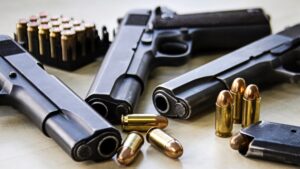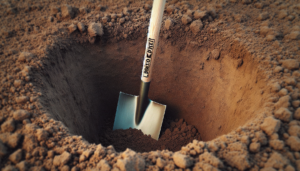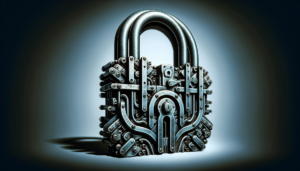Firearm accessories play a significant role in enhancing the functionality and performance of firearms, but understanding their advantages and disadvantages is crucial for making informed decisions. This article explores the pros and cons of various firearm accessories, providing valuable insights that will enable you to choose the right accessories based on your needs and preferences. Whether you’re a seasoned shooter or a novice looking to upgrade your firearm, this article will equip you with the knowledge necessary to navigate the vast array of accessories available in the market.
Optics
Optics are an essential aspect of modern firearms, providing shooters with enhanced accuracy and target acquisition. Among the different types of optics available, red dot sights, magnified optics, and night vision optics offer distinctive advantages and disadvantages.
Red Dot Sights
Red dot sights are popular choices for both professional shooters and amateurs due to their versatility and ease of use. These optics utilize a small illuminated dot as the aiming point, allowing for quick and intuitive target acquisition. One of the significant advantages of red dot sights is their ability to provide rapid target engagement, particularly in close-quarters scenarios. With both eyes open, shooters can maintain situational awareness while simultaneously aiming accurately.
Another benefit of red dot sights is their capability to work in various lighting conditions. The illuminated dot remains visible even in low light or bright sunlight, ensuring target acquisition is not compromised. Additionally, red dot sights are typically lightweight and compact, making them suitable for use on rifles, shotguns, and handguns.
However, one potential drawback of red dot sights is their lack of magnification. While they excel in close-quarters situations, their effectiveness diminishes at longer ranges, where magnification is required for precise accuracy. Moreover, red dot sights are electronic devices powered by batteries, and if the battery runs out during a critical moment, the optic becomes non-functional.
Magnified Optics
Magnified optics, such as riflescopes, provide shooters with the ability to engage targets at extended distances with enhanced precision. By magnifying the target image, these optics enable accurate aim and shot placement. Magnified optics are commonly used in hunting, long-range shooting, and precision rifle competitions.
One of the primary advantages of magnified optics is their ability to provide a clear and detailed view of targets at various distances. The magnification allows shooters to identify and engage targets more effectively, even at extended ranges. Additionally, many magnified optics offer adjustable zoom levels, providing shooters with flexibility depending on the situation.
Another benefit of magnified optics is their superiority in low-light conditions. Unlike red dot sights, most magnified optics feature larger objective lenses, allowing more light to enter the scope. This increased light gathering capability enhances visibility in low-light environments, making it easier to identify targets and acquire them accurately.
However, magnified optics have their limitations as well. The added magnification contributes to a larger and heavier optic, which may affect the overall balance and maneuverability of the firearm. This can be a disadvantage in dynamic shooting scenarios that require quick target transitions or movement. Additionally, a higher magnification level may narrow the shooter’s field of view, potentially reducing situational awareness.
Night Vision Optics
Night vision optics offer shooters the ability to see and engage targets in low or no-light conditions, providing a significant advantage in tactical situations or nighttime operations. These optics utilize advanced technology to amplify ambient light or infrared illumination, enabling clear visibility in the dark.
One of the primary advantages of night vision optics is their ability to enhance situational awareness and target identification in complete darkness. By amplifying the available light or utilizing infrared illumination, shooters can navigate and engage targets without relying solely on ambient light sources. This gives tactical teams, law enforcement personnel, and military operators an edge in nighttime operations.
Night vision optics also excel in scenarios where stealth and covert operations are crucial. With the ability to see in the dark, shooters can approach targets undetected, increasing their chances of success. The use of infrared illumination further enhances this stealth advantage, as it is invisible to the naked eye but can be detected by night vision equipment.
However, night vision optics do come with some disadvantages. Firstly, they can be quite expensive, making them less accessible to the average firearm owner. Additionally, the visibility and effectiveness of night vision optics can be influenced by environmental factors such as heavy fog, rain, or dust. These conditions may reduce the ability to effectively engage targets or compromise clarity.
Suppressors
Suppressors, also known as silencers, are firearm accessories designed to reduce the noise and muzzle flash produced during the firing of a weapon. While popularized in movies, the use of suppressors provides various pros and cons.
Pros of Suppressor Use
One of the primary advantages of using suppressors is the reduction in noise produced by the firearm upon firing. This is particularly beneficial in shooting ranges, where noise pollution can be a concern. By diminishing the noise signature of the firearm, suppressors create a more pleasant shooting experience for the shooter and those in proximity to the range. Additionally, the reduced noise allows for easier communication between shooters and instructors on the range.
Furthermore, suppressors contribute to hearing protection. Firearms discharge at close range can reach decibel levels that cause immediate and long-term damage to hearing. Suppressors help mitigate this risk by attenuating the noise levels, providing a safer shooting environment. This is especially important for professionals, such as law enforcement officers and military personnel, whose exposure to firearm noise is more frequent.
Another advantage of suppressor use is the reduction of muzzle flash. By redirecting and cooling the hot gases expelled from the barrel upon firing, suppressors minimize the bright muzzle flash that can temporarily impair the shooter’s vision. This can be beneficial in low-light or tactical situations where stealth and reduced visibility are crucial.
Cons of Suppressor Use
One of the significant drawbacks of suppressor use stems from the legal restrictions and regulations surrounding them. In many jurisdictions, suppressors are tightly regulated, requiring extensive paperwork, background checks, and obtaining special permits or tax stamps. These legal hurdles and associated costs can deter firearm owners from utilizing suppressors, limiting their accessibility.
Additionally, suppressors can increase the overall length and weight of a firearm. This change in the firearm’s dimensions can affect its ergonomics, balance, and maneuverability, making it less suitable for certain applications. It is important for shooters to consider this factor when choosing to mount a suppressor on their firearm.
Furthermore, the use of suppressors may impact the ballistic performance of the ammunition being fired. The added backpressure and decreased airflow caused by the suppressor can influence the velocity, trajectory, and reliability of the rounds. Shooters must carefully select ammunition that is compatible with their specific suppressor setup to optimize performance.
Tactical Lights
Tactical lights, also known as weapon-mounted lights, are devices attached to firearms to provide illumination in low-light or tactical situations. These accessories come with their own set of advantages and disadvantages.
Advantages of Tactical Lights
One of the primary advantages of tactical lights is the increased visibility they offer in low-light environments. When entering dark areas or encountering low-light situations, having a weapon-mounted light allows shooters to quickly identify potential threats and effectively engage them. This is particularly valuable for law enforcement officers, military personnel, and self-defense situations.
Tactical lights also serve as a valuable tool for searching and clearing dark areas, allowing shooters to illuminate their surroundings while keeping both hands free for other tasks. By eliminating the need for handheld flashlights, shooters can maintain better control of their firearm and execute necessary actions more efficiently.
Another advantage of tactical lights is their ability to disorient and temporarily impair the vision of an adversary. When a bright light source is unexpectedly shone in someone’s eyes, their ability to see clearly is severely compromised, providing a potential advantage for the shooter. This momentary disorientation can allow the shooter to gain the upper hand or create a window of opportunity to escape or engage the threat effectively.
Disadvantages of Tactical Lights
One significant drawback of tactical lights is the potential for unintended or accidental activation. In high-stress situations, individuals may inadvertently activate the light, potentially compromising their position or revealing their presence to adversaries. Such accidental illumination can give away the shooter’s location, making them an easy target.
Additionally, tactical lights can create shadows and reflections, potentially revealing the shooter’s position to an observant adversary. The emitted light can bounce off walls or other surfaces, providing visual cues that adversaries can exploit. Shooters must be mindful of their positioning and use the light judiciously to mitigate this risk.
Furthermore, tactical lights require a power source, typically batteries. It is essential to ensure that the light is adequately charged or fitted with fresh batteries to prevent a sudden loss of illumination during a critical moment. Regular maintenance and battery checks are crucial to ensure reliability.
Foregrips and Bipods
Foregrips and bipods are accessories designed to improve stability, control, and accuracy when shooting firearms, particularly rifles. While they offer notable benefits, they also come with a few drawbacks.
Benefits of Foregrips and Bipods
One of the primary benefits of foregrips and bipods is the enhanced stability they provide when shooting from various positions. By providing a solid contact point between the firearm and the shooter’s support hand or surface, these accessories help reduce muzzle rise and recoil. This stability allows shooters to maintain better control over the firearm, resulting in improved accuracy, especially during sustained fire.
Additionally, foregrips and bipods offer increased comfort, particularly during longer shooting sessions or in prone positions. By introducing a forward grip or a reliable rest, shooters can minimize fatigue and muscle strain, reducing the potential for unsteady or erratic shots. This added comfort is particularly advantageous for precision shooting or situations that require extended periods of time in a fixed position.
Furthermore, foregrips and bipods enhance the shooter’s ability to engage targets at long distances accurately. With the firearm stabilized, shooters can focus on precise shot placement and make adjustments for windage and elevation more effectively. This stability and accuracy are particularly valuable for hunters, long-range shooters, and snipers.
Drawbacks of Foregrips and Bipods
One downside of utilizing foregrips and bipods is the potential increase in weight and size of the firearm. These accessories add bulk to the front end of the weapon, affecting its balance and overall maneuverability. In situations that require swift target transitions or movement, the added weight can hinder the shooter’s ability to respond quickly.
Another drawback is the limited versatility of foregrips and bipods in certain shooting positions or environments. While bipods excel in prone or supported shooting positions, they can be impractical or cumbersome in other situations, such as shooting from behind cover or in tight spaces. Shooters must consider the specific requirements of their shooting scenario to determine whether the additional stability provided by these accessories outweighs any potential limitations.
Furthermore, foregrips and bipods can interfere with the compatibility and ease of use of other firearm accessories, such as rail systems or suppressors. The attachment and positioning of these accessories may require adjustments to ensure proper fit and functionality, adding to the overall complexity of the setup.
Extended Magazines
Extended magazines, commonly known as high-capacity magazines, offer shooters the ability to carry and fire more rounds without reloading. While they can be advantageous in certain scenarios, they also come with some notable drawbacks.
Pros of Using Extended Magazines
One of the primary advantages of using extended magazines is the increased ammunition capacity they provide. In situations where a high volume of fire is required, such as prolonged engagements or firefights, extended magazines allow shooters to have more rounds readily available without the need for frequent reloads. This can be particularly valuable in self-defense scenarios or in competitive shooting disciplines that require rapid and continuous fire.
Additionally, extended magazines offer shooters peace of mind, knowing that they have more rounds available before needing to reload. This added firepower can provide a psychological advantage in high-pressure situations, potentially deterring adversaries or allowing the shooter to maintain control of the engagement for a longer duration.
Furthermore, extended magazines can be beneficial for individuals with reduced mobility or physical limitations. Reloading a firearm quickly and efficiently may be challenging for some shooters, and extended magazines help mitigate this issue by reducing the frequency of reloads. Elderly or disabled individuals, for instance, may find extended magazines particularly advantageous in self-defense scenarios.
Cons of Using Extended Magazines
A significant drawback of using extended magazines is their increased size and weight. The larger capacity often comes at the expense of added bulk, making the firearm more cumbersome and affecting its balance and handling. This can be a disadvantage in scenarios that require quick maneuvering or require the shooter to navigate tight spaces.
Another disadvantage is the potential impact on reliability and weapon functionality. Extended magazines can introduce feeding or ejection issues, particularly if the design or construction of the magazine is not of sufficient quality. Reliability is paramount in firearm usage, and shooters must carefully test and evaluate extended magazines to ensure they function flawlessly with their specific firearm.
Additionally, extended magazines may attract attention or scrutiny in jurisdictions with restrictions or bans on high-capacity magazines. The legalities surrounding their possession and use can vary significantly from one jurisdiction to another, with potential legal consequences for non-compliance. Shooters should be familiar with local laws and regulations before deciding to utilize extended magazines.
Suppressor Covers
Suppressor covers are accessories designed to mitigate the thermal mirage effect caused by the hot gases produced during firearm discharge. While they offer several advantages, suppressor covers also present a few disadvantages.
Advantages of Suppressor Covers
One of the primary advantages of using suppressor covers is the reduced thermal mirage effect. When shooting rapidly or engaging multiple targets, the heat generated by the suppressor can create a mirage, distorting the shooter’s view and potentially compromising accuracy. By insulating the suppressor and creating a barrier between the hot gases and the surrounding air, suppressor covers minimize the thermal mirage effect, allowing for clearer target acquisition and engagement.
Another benefit of suppressor covers is their ability to protect the shooter and surrounding objects from accidental contact with the hot suppressor during or after firing. Suppressors can reach extremely high temperatures quickly, posing a burn hazard. The cover acts as an insulating barrier, reducing the risk of unintentional burns.
Additionally, suppressor covers offer camouflage capabilities, particularly in tactical or hunting scenarios. Covers come in various colors and patterns, allowing shooters to match the cover to their environment or personal preferences. This can provide a degree of concealment and reduce the likelihood of the suppressor drawing unwanted attention.
Disadvantages of Suppressor Covers
One potential disadvantage of using suppressor covers is the added weight and bulk they introduce to the firearm. The cover can alter the balance and maneuverability of the weapon, affecting its overall ergonomics. For shooters in dynamic or fast-paced shooting situations, this additional bulk may impact their ability to respond quickly or transition between targets efficiently.
Another drawback is the potential impact on suppressor performance, particularly in rapid-fire or sustained fire scenarios. The cover can cause heat buildup and retention within the suppressor, potentially leading to increased operating temperatures and reduced efficiency. Shooters must consider the impact of the cover on the suppressor’s overall performance and reliability when making their decision.
Furthermore, suppressor covers may require periodic maintenance and cleaning to remove accumulated debris, residue, or moisture. Failure to maintain the cover properly may result in reduced functionality or degradation over time. Shooters must be prepared to allocate time and resources for this additional maintenance aspect.
Trigger Modifications
Trigger modifications are alterations made to the trigger mechanism of a firearm to enhance performance, improve trigger pull, or increase accuracy. While they offer potential benefits, trigger modifications also carry some risks.
Benefits of Trigger Modifications
One of the primary benefits of trigger modifications is the potential improvement in trigger pull. A smoother and lighter trigger pull can enhance the shooter’s ability to maintain aim and execute accurate shots. This can be particularly advantageous in precision shooting disciplines, where minimal trigger movement and crisp breaks are essential.
Additionally, trigger modifications can reduce the overall travel distance and reset of the trigger, enabling faster follow-up shots. By shortening the reset and improving the feedback, shooters can fire subsequent rounds more rapidly while still maintaining control and accuracy.
Furthermore, trigger modifications can enhance the shooter’s overall comfort and ergonomics when using the firearm. A well-tuned trigger can reduce fatigue, minimize finger fatigue and strain, and improve the overall shooting experience. Shooters who spend significant time on the range or engage in competitive shooting may find trigger modifications particularly beneficial.
Risks of Trigger Modifications
One significant risk associated with trigger modifications is the potential compromise to firearm safety. Altered trigger mechanisms may affect the firearm’s ability to prevent accidental discharges or may reduce the reliability of safety mechanisms. Any modifications made to the trigger should prioritize safety and be performed by a qualified professional gunsmith.
Additionally, trigger modifications can impact the legal compliance of the firearm, depending on jurisdiction. Some jurisdictions have specific regulations regarding trigger modifications, especially in the context of concealed carry or duty firearms. Shooters must ensure that any modifications made to their triggers comply with local laws to avoid legal consequences.
Furthermore, trigger modifications may void the firearm manufacturer’s warranty. If a firearm requires repairs or maintenance, the manufacturer may refuse service or charge additional fees if unauthorized modifications have been made. Shooters should consult the manufacturer’s guidelines and warranty policies before proceeding with any trigger modifications.
Sling Attachments
Sling attachments are accessories that allow shooters to secure their firearms to slings, providing improved weapon retention, ease of carry, and tactical versatility. While sling attachments offer several advantages, they also come with a few disadvantages.
Pros of Sling Attachments
One of the primary advantages of using sling attachments is the improved weapon retention they provide. By securely attaching the firearm to a sling, shooters can keep the weapon close and easily accessible, preventing accidental drops or loss of control. This is particularly valuable in dynamic or tactical scenarios where rapid movements or transitioning between different shooting positions is required.
Sling attachments also offer enhanced ease of carry, especially during long hikes, patrol duties, or extended periods of firearm carriage. By redistributing the weight of the firearm across the shooter’s body, slings reduce fatigue and muscle strain, allowing for more comfortable carrying over extended durations. This can be critical for military personnel, law enforcement officers, or hunters who need to carry their firearms for extended periods.
Another advantage of sling attachments is their ability to enable rapid firearm deployment. With the firearm secured to the body via a sling, shooters can quickly transition from a slung position to a firing position, minimizing the time required to engage a threat. This quick deployment capability offers a significant advantage in self-defense or emergency situations.
Cons of Sling Attachments
One of the potential drawbacks of sling attachments is the added complexity they introduce to the overall firearm setup. Depending on the type of sling used and the specific attachment method, shooters may need to spend additional time and effort to properly adjust and attach the sling. This may pose challenges in high-stress situations where immediate action is required.
Additionally, sling attachments can interfere with the compatibility and ergonomics of other accessories or equipment used alongside the firearm. The attachment points may obstruct the optimal positioning or operation of other devices, such as optics, foregrips, or laser aiming devices. Shooters must carefully consider the potential conflicts and make adjustments to ensure all components work harmoniously.
Furthermore, in certain close-quarters situations, slings can become entangled or caught, potentially impeding the shooter’s movement or compromising their ability to quickly bring the firearm into action. It is essential to train and practice with sling usage to fully understand the limitations and mitigate any risks associated with potential entanglements.
Rail Systems
Rail systems, commonly referred to as Picatinny or M-Lok rails, provide shooters with a versatile platform for attaching various accessories to their firearms. Rail systems offer several advantages, but they also introduce a few drawbacks.
Advantages of Rail Systems
One of the primary advantages of rail systems is their ability to facilitate the attachment of multiple accessories to a single firearm. With the standardized rail interface, shooters can mount optics, lights, lasers, grips, and other accessories in various configurations to meet their specific needs. This versatility allows for customization and adaptability depending on the shooting scenario or mission requirements.
Additionally, rail systems provide a secure and repeatable mounting solution for accessories. By utilizing precise attachment points and locking mechanisms, rail systems ensure that accessories remain securely fixed to the firearm, even during recoil or high-stress situations. This enhances reliability and consistency, critical factors for accuracy and effective target engagement.
Furthermore, rail systems promote modularity, allowing shooters to easily swap or reposition accessories as needed. The ability to quickly adapt the firearm setup to suit different scenarios or changing mission requirements enhances the shooter’s versatility and operational flexibility. This modularity is particularly beneficial for law enforcement officers, military personnel, or competitors who need to optimize their firearms for specific tasks.
Disadvantages of Rail Systems
One potential drawback of rail systems is the added weight and bulk they contribute to the firearm. The rail segments, attachment hardware, and accessories themselves can collectively increase the overall dimensions and heft of the firearm. This can potentially affect maneuverability, balance, and handling, particularly in situations that demand quick target transitions or rapid movement.
Additionally, rail systems can be less aesthetically pleasing to some shooters who prefer a more streamlined and minimalist firearm profile. The additional accessories and mounting points may create a cluttered or busy appearance, which may not be visually appealing to those seeking a cleaner aesthetic.
Furthermore, rail systems come with a cost, both in terms of financial investment and added complexity. High-quality rails and compatible accessories can be expensive, potentially limiting accessibility for some shooters. Additionally, the selection, installation, and adjustment of rail-mounted accessories may require specialized tools and expertise. Shooters must consider the financial and technical aspects when deciding to utilize rail systems.
Extended Controls
Extended controls are firearm accessories designed to enhance the ease of operation and manipulation of various firearm functions, such as the magazine release, bolt catch, or charging handle. While they offer certain advantages, extended controls also come with a few drawbacks.
Pros of Extended Controls
One of the primary advantages of extended controls is the improved ergonomics and ease of use they provide. By extending the reach or enlarging the surface area of critical firearm controls, shooters can more easily access and activate these functions. This can be particularly beneficial for individuals with smaller hands or those wearing gloves, as it reduces the risk of fumbling or difficulty in operating the controls.
Additionally, extended controls can enhance the speed and efficiency of firearm manipulation, particularly during reloads or clearing malfunctions. With larger or more accessible controls, shooters can quickly locate and activate the necessary functions without sacrificing their grip or needing to adjust their shooting stance significantly. This can contribute to faster and smoother firearm operations.
Furthermore, extended controls can minimize the risk of unintentional activation or engagement. By extending the controls further out from the firearm frame or receiver, shooters can reduce the likelihood of inadvertently activating a control due to accidental contact or unintended pressure. This enhances safety and prevents potentially dangerous outcomes.
Cons of Extended Controls
One potential drawback of extended controls is the potential for accidental engagement or interference with other objects or equipment. The extended profile or enlarged surface area can increase the likelihood of contact and may inadvertently activate controls, leading to unintended magazine drops, bolt releases, or other unwanted outcomes. Shooters using extended controls must be mindful of their positioning and take care to minimize accidental contact.
Additionally, extended controls can potentially alter the overall profile or shape of the firearm, affecting its holster compatibility or concealability. Concealed carry or duty firearms require careful consideration of the extended controls, ensuring they do not interfere with the ability to securely and comfortably carry the firearm in a preferred holster or configuration.
Furthermore, extended controls may not be universally beneficial for all shooters. Individuals with larger hands or those already accustomed to the standard controls may not experience a significant improvement in usability or may find the extended controls unnecessary. Additionally, extended controls may add complexity and a learning curve, requiring shooters to adapt their muscle memory and retrain their motor skills to accommodate the altered controls.
In conclusion, firearm accessories offer shooters various pros and cons depending on their specific needs and shooting scenarios. Optics enhance accuracy and target acquisition, with red dot sights excelling in close-quarters situations and magnified optics providing precision at longer ranges. Night vision optics offer visibility in low or no-light conditions, ideal for tactical or nighttime operations.
Suppressors reduce noise and muzzle flash, offering benefits such as improved shooter comfort, hearing protection, and reduced recoil. However, they may face legal restrictions and impact the firearm’s balance and maneuverability. Tactical lights provide enhanced visibility in low-light environments but may accidentally reveal the shooter’s position or cause shadows and reflections. Foregrips and bipods offer stability and accuracy but increase weight and may limit versatility. Extended magazines provide additional firepower but introduce bulk and may attract legal scrutiny.
Suppressor covers reduce thermal mirage and protect against burns but may affect suppressor performance and require maintenance. Trigger modifications improve trigger pull and speed but can compromise safety and legal compliance. Sling attachments enhance weapon retention and ease of carry but can become entangled or obstruct other equipment. Rail systems provide versatility and modularity but add weight and complexity. Extended controls improve ergonomics and ease of use but may accidentally engage or interfere with other objects.
Understanding the advantages and drawbacks of these firearm accessories allows shooters to make informed decisions that suit their specific needs, preferences, and shooting requirements. Ultimately, selecting and utilizing the appropriate accessories can significantly enhance the overall shooting experience, accuracy, and operational effectiveness.






